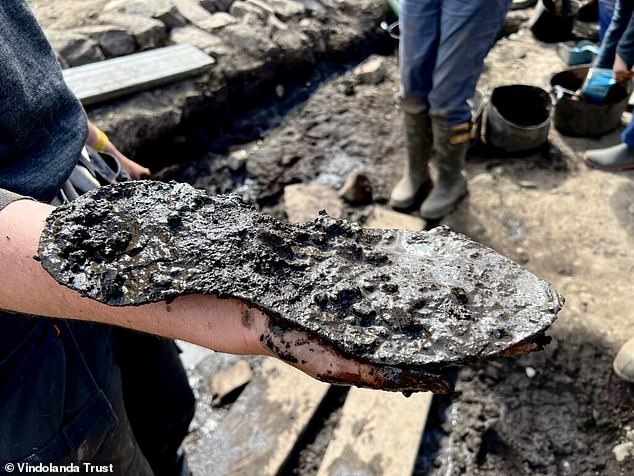[ad_1]
Archaeologists have always said that Romans left a massive footprint in Britain, but they probably didn’t mean it quite so literally.
Scientists have discovered an enormous shoe belonging to a Roman soldier with massive feet.
The hefty leather sole measures 12.6 inches (32cm) from toe to heel – the equivalent of a modern men’s size UK 13.
That means this 2,000-year-old centurion had bigger feet than muscleman Arnold Schwarzenegger, who stands at 6ft 2″ (188cm) tall.
The archaeologists who found it said the discovery ‘drew impressed gasps’ as it was pulled from the ground.
The shoe was found in the grounds of Magna, a Roman fort built along Hadrian’s Wall around 112 AD.
It was found alongside two others inside an ‘ankle breaker’ trench, a vicious trap consisting of a narrow, deep trench that would be almost invisible to approaching soldiers.
However, the archaeologists don’t say whether this shoe was lost by someone falling prey to the ankle breaker.

Scientists have discovered a massive Roman shoe at the remains of a fort near Hadrian’s Wall. In modern measurements, this shoe would be a size 13
Compared to other Roman structures in Britain, Magna is relatively un-excavated, but digs are now beginning to yield some exciting discoveries.
In late March, the archaeologists began to excavate the outer ring of defensive ditches, ramparts, and banks that had been built on the North side of the fort.
Among some fragments of pottery and scraps of leather, the researcher’s most exciting discovery was the three, remarkably well-preserved shoes.
Two of these were almost intact, with one still maintaining part of the heel section and a row of hobnails along the bottom of the sole.
But it was the enormous size 13 shoe which generated the most excitement.
Rachel Frame, Magna Project senior archaeologist, says: ‘Although in this case only one of the several sole layers, the sheer size of the shoe and guesses about who could have worn it dominated the conversation.
‘Could this one be the largest in the Vindolanda Trust collection? We certainly look forward to finding out!’
With size 13 feet, the owner of these huge shoes had the same size feet as the 6ft 4″ (195 cm) actor Stephen Fry.

The shoe was found alongside two others (pictured) in an ‘ankle breaker trench’. This is a narrow, deep trench that would be hidden when filled with water, tripping up approaching soldiers and breaking their ankles

These finds reveal how Romans made their shoes with multiple layers of leather in the sole and reinforced areas for walking like a modern walking boot
Likewise, their feet were only just smaller than those of Stephen Merchant who stands at a towering 6 ft 7 in (201 cm)
Hadrian’s Wall, named after the Roman emperor Hadrian, was constructed in 122 AD to separate the Roman-occupied territories in the south from the unconquered lands of Scotland.
As the Romans built the wall and consolidated their rule over Britain, they also constructed several small forts across the country.
Magna, also known as Carvoran, is one of the forts that was built along the wall during this period.
Located seven miles (11 km) west of the large Roman fort Vindolanda, which has been the site of many archaeological finds, this smaller fortification was constructed to guard the crossroads of two major Roman roads.
These discoveries also help archaeologists to get a better understanding of how the Romans made their shoes.
Ms Frame says: ‘This gives us a really good look at how Roman shoes were made: multiple layers of leather were used to form the sole, held together with thongs, stitching and hobnails.

Magna Fort (artist’s impression) was built to protect a crossroads of two major Roman roads which supplied nearby towns and fortifications
‘These also reinforced the outer surface for walking and are found on many styles of shoe.’
This discovery is important because organic materials like leather or wood are normally broken down by microbes in the soil before archaeologists can find them, making leather shoes an exciting find.
Only when it is kept in a wet environment with limited oxygen can leather last for thousands of years.
But if the soil dries out, microbes can get to the materials and start to break them down.
The archaeologists excavating the Magna Fort are currently concerned that this year’s exceptionally dry spring might lead to some artefacts decaying before they are found.
In the first two weeks of May, the Magna site received less than half a millimetre of rain, leaving the soil unusually dry.
Franki Gillis, geoarchaeologist for the Magna Project, says: ‘At Magna, the lack of rain has caused the groundwater level to drop considerably.
‘So although nice, this abnormally lovely warm spring, may be harmful to the continual preservation of our organic finds at Magna and Vindolanda.’
[ad_2]
This article was originally published by a www.dailymail.co.uk . Read the Original article here. .

